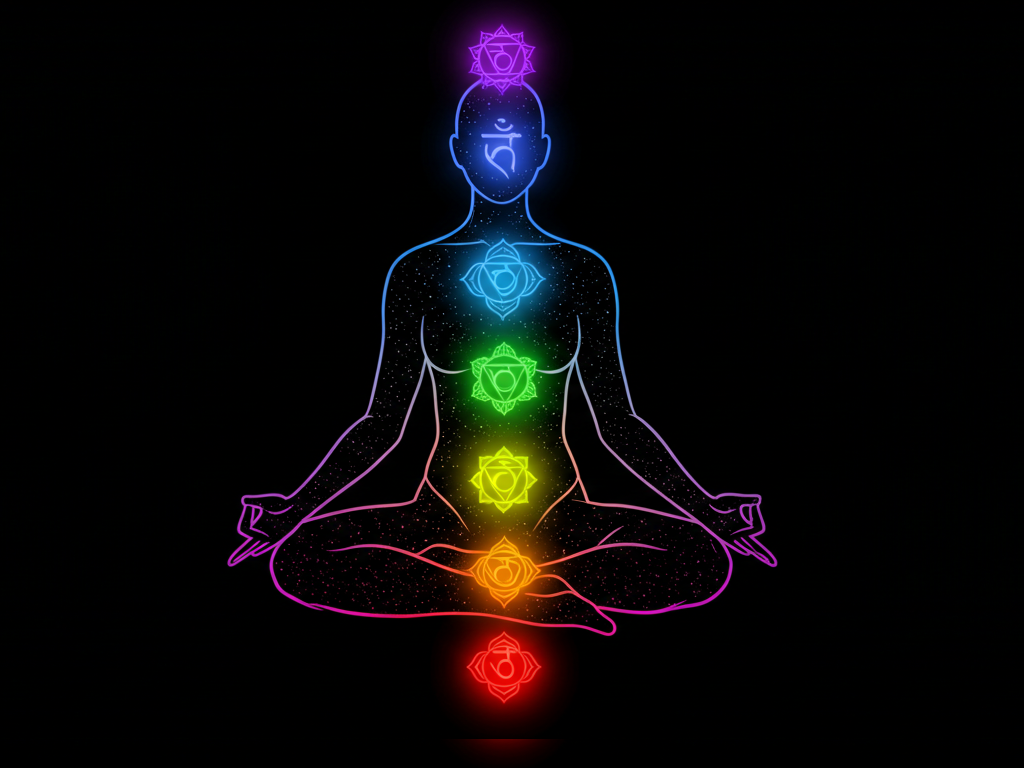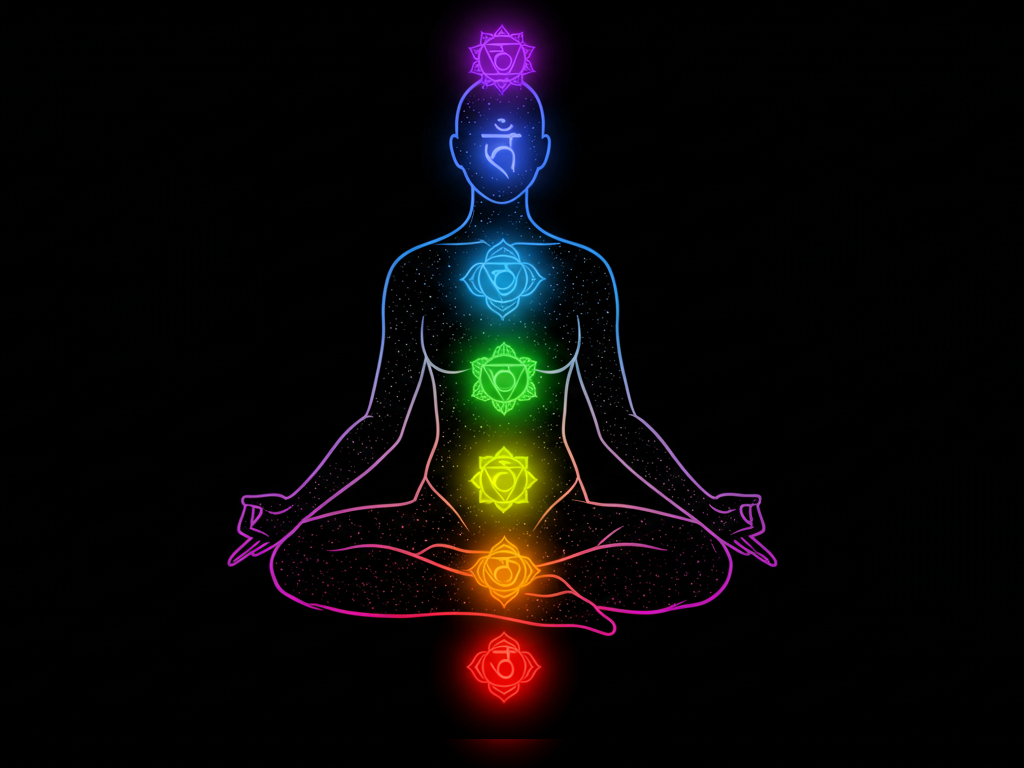J. Aaron Stanley, Composer
Chakras, Op. 10 for Woodwind Quintet and Percussion
Chakras, Op. 10 for Woodwind Quintet and Percussion
Couldn't load pickup availability
Chakras: A Musical Journey of Enlightenment, Op. 10 for Woodwind Quintet and Percussion
- Instrumentation: Fl., Ob., Cl. Hn., Bsn., 3 Perc. (Vib., Mar./W.B., Gongs)
- Opus 10, 2019
- Duration: c. 18m
Chakras is a concert work inspired by the process of spiritual awakening and enlightenment as described by Eastern mysticism. I, personally, do not claim to be particularly “awakened,” and certainly not “enlightened” in the guru sense. Nor do I assert this piece to be particularly “spiritual,” nor was it written to accompany meditation. It would surely be too distracting, and not “ambient” enough to serve those purposes. It is meant to be actively listened to and enjoyed, as one actively participates in the enjoyment of a good painting. Think of Chakras as “aural painting” inspired by descriptions of what each chakra represents and the aspects of consciousness they are associated with.
I used written descriptions, along with my own meditations, to spark the imagination and inspire musical motives, textures, harmonies, etc. In that sense, Chakras is the most “spiritual” piece I've ever composed. But if you think about it, any creative act is a spiritual act and therefore one piece of music isn't inherently more “spiritual” than another. The act of creation itself requires a connection to the Divine – the Ultimate Source of all Creation.
“Chakras” is the Sanskrit term referring to what many esoteric spiritual traditions identify as energy centers within the body that correspond to different aspects of consciousness and experience. There are seven, according to the yoga tradition, situated along the spine from the tailbone (The Root Chakra) to the top of the head (The Crown Chakra).
A person who dedicates himself to meditation and spiritual advancement is filled with an intense desire to connect with the Divine. The meditation awakens the kundalini, represented metaphorically as a serpent that coils its way up the spine, awakening each energy center as it goes.
Chakras is in 8 movements, each roughly two minutes long, with each movement segueing smoothly to the next:
- Awakening
- The Root Chakra (Muladhara)
- The Sacral Chakra (Svadhisthana)
- The Solar Plexus Chakra (Manipura)
- The Heart Chakra (Anahata)
- The Throat Chakra (Vishuddhi)
- The Third Eye Chakra (Ajna)
- The Crown Chakra (Sahasrara)
It took me 8 years to write this piece. I started in 2011, when I was still in Los Angeles. I wrote movements I, II, and VI relatively quickly, but the rest, especially III, eluded me. I started it many times, only to throw the draft away.
Shortly after, I moved to Mexico, which was a "dormant" period compositionally. I focused mostly on performing and arranging for my ensembles during that time, and hardly composed a note. But by 2018, I was back in the states, living in Dallas, TX, when I felt an intense urge to compose again.
That was the start of a very productive period, and Chakras was one of the first pieces I finished. By this point, the rest of the piece came together more naturally, except for movement III, which went through several rewrites before I was finally happy with it.
Awakening
The first movement depicts the intense longing for a spiritual connection to the Divine. There is no melody, but rather fragmented musical motives—the random, uncontrolled thoughts and feelings of the mind. The intense longing begins to awaken the kundalini (represented by the oboe—a gradually emerging melody influenced by Middle Eastern snake charmers).
The Root Chakra
The start of the mallet percussion begins the meditation which eventually fully awakens the kundalini (played first by the oboe, and answered by the horn and flute). Each time the kundalini theme reappears from here on out, it signals a change in energy and a transition to the next chakra.
The Root Chakra deals with connection to the earth, and feelings of safety and security.
The Sacral Chakra
Most people are aware of the sacral chakra as the “sex center.” Indeed it is, but it is more than that. It is the center of creation, procreation, and creativity. Also playfulness. For that reason, I chose not to make it overtly sexual or bawdy. I wanted to maintain a certain sense of playfulness, and depict an explosion of creativity (heard particularly after the kundalini theme completes).
The Solar Plexus Chakra
The Solar Plexus Chakra deals with intention, and the courage to exercise freewill. It also deals with self-esteem, personal power, humor, and optimism. The horn leads the charge here, representing courage and optimism. Later, other instruments take up the theme, while the horn “dances” in counterpoint with them. The appearance of the clarinet on the kundalini theme signals the transition to the next chakra.
The Heart Chakra
The Heart Chakra is the center of love in all its forms: compassion, tenderness, connection, etc. Here it is represented first by the solo flute, then the solo clarinet. The horn takes up the kundalini theme this time (it takes courage to love), and the music transitions to the next chakra.
The Throat Chakra
The Throat Chakra is the center of communication and cognitive thought, and the most direct connection to the physical world, the world bound by time. For that reason, the tempo is an exact quarter note = 120 beats per minute (clock time). Musically, the section is full of palindromes, but the overall effect is one of neurons firing in an active, intelligent mind. The flute and clarinet take up the kundalini theme in a canon that signals the shift to the next chakra.
The Third Eye Chakra
While the Throat Chakra is the cognitive link to the physical world, the Third Eye Chakra is the cognitive link to the spiritual one. For that reason, it is perhaps the most mysterious of them all. It is through the Third Eye people see auras, have visions, see angels or demons, or visit other worlds in the astral plane. It is not all light and rainbows. It can be a deeply unsettling experience for many people.
The music depicts the mystery and unsettling nature of this experience, but by embracing the mystery, and accepting this connection, the kundalini is free to move into the Crown Chakra.
The Crown Chakra
The Crown Chakra is the gateway to the gods, or God, or Infinite Consciousness, or The Universe, or ascension, or however you wish to describe it. It is the moment of triumph, the “graduation” from the school of duality into the next plane of existence, and whatever further discoveries await there. The ending of my work is intended to communicate that there is no end... the journey goes on for all eternity, and has merely shifted into another realm of existence beyond our current reach.
Share

